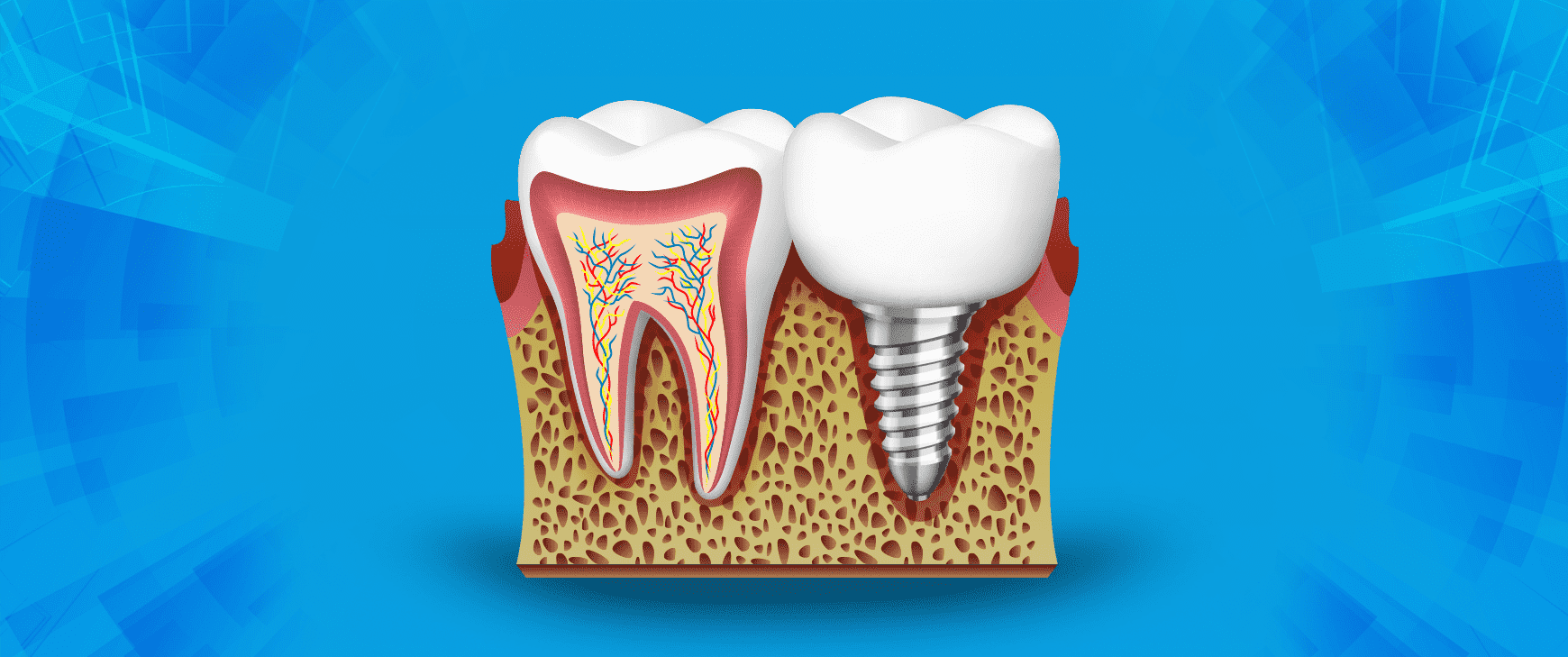Single Tooth Implant Treatment
Salih ÖNDER2024-11-06T22:26:04+03:00What is an implant?
Tooth deficiencies are a very important problem that negatively affects a person’s life both in terms of health and aesthetics. People living with these deficiencies may experience many problems such as serious digestive system problems, avoiding smiling, and withdrawing from social life over time. However, a much healthier and more comfortable life is possible with the correct compensation of tooth deficiencies.
Many years ago, only traditional tooth and jaw prostheses were applied to eliminate tooth deficiencies. These prostheses are fixed bridge prostheses in which healthy teeth are cut and reduced depending on the amount of missing teeth, or removable removable prostheses where it is very difficult for the patient to reach sufficient comfort.
Especially in people using removable dentures, the melting of the jaw bones over time due to the force they are exposed to can make it impossible for the person to chew properly. Prostheses that cannot find sufficient support can play in the mouth in every movement and cause various problems during speech.
In fixed prostheses, even in the absence of a single tooth, cutting the healthy teeth to get support from the two adjacent teeth causes discomfort. With the development of biocompatible dental implants that are compatible with body tissues and harmless to human health, it has become possible to eliminate tooth deficiencies in a much healthier and more comfortable way.
Basically, implant applications meet the load of the dental prosthesis it carries by taking support from the jawbone like a real tooth root, creating a much more natural and healthy chewing, speaking and appearance. For this reason, dental implants are the most accurate treatment for missing teeth.
In tooth implant Turkey has a lot of dental clinics to offer. However, it is important to choose the right place if you are looking for a good dentist in Istanbul Turkey. Dental Group Hospitadent serves you in all its branches and with its qualified expert staff, in the light of the latest technology, for the most healthy and comfortable solution of your tooth deficiencies.
What are the advantages of the implant and to whom can it be applied?
Sometimes dental implants are planned for one or a few missing teeth and sometimes for an entire edentulous mouth. Implants can be applied for the use of a completely fixed prosthesis as well as to facilitate the use of removable prostheses.
The general health of the patient also plays an important role in implant planning. Although it is a simpler surgical procedure than it is thought, the general health of the patient must be in place for implant procedures. In cases of heart, blood pressure, diabetes and some blood diseases or the use of certain drugs that affect bone formation and healing, implant surgeries can only be performed with the help of specialist doctors and with special precautions.
In addition, bone development is expected to be completed for dental implant applications in young individuals where bone development still continues.
Implant treatments are not recommended for people who have received radiotherapy from the head and neck region, since bone healing will be difficult.
Excessive smoking is also an obstacle to implant treatment due to its negative effect on healing. For a successful treatment outcome, it is recommended that the patient quit smoking first.
In order to learn about this issue more, feel free to contact us. As one of the most advanced and reputable dental clinics in Istanbul Turkey, Hospitadent can meet your needs.
What should be done before implantation?
- A complete examination and planning is very important in implant treatments. For a correct planning, besides the intraoral examination, radiography, that is, x-ray images and sometimes computerized tomography are used.
- After the necessary bone measurements are made in X-rays and tomographs, implants and prostheses are planned for the needs of the patient.
- The patient must have good oral hygiene. If there are needs such as dental cleaning, gingival treatments, filling, root canal treatment before the implant, these treatments are carried out and oral hygiene is made suitable for implant applications.
- If the patient has a health problem that requires special precautions before implantation, necessary precautions are taken in line with the directions of the relevant doctors and the patient is fully prepared for the implant intervention.
What is bone graft (bone powder) and when is it used?
Sometimes, due to various reasons, the jawbones to which the implant will be applied may not be of sufficient height and quality. In these cases, before implant surgery or in the same session, jawbone lifting and feeding practices called “grafting” are applied.
Especially in the upper jaw, sometimes sinus sagging is accompanied by bone loss, and there is not enough bone in the area to be implanted. In this case, a special grafting operation called “sinus lifting” is performed and bone grafts known as “bone powder” are applied to the area.
In general, bone grafts are obtained from cattle and are used in powder form. However, in some cases where bone loss is too much, parts taken from the person’s own bones, called “autogenous grafts”, need to be transplanted to the implanted areas. Although this situation is rare, especially for many years, full pro
It should be noted that autogenous grafts are used in patients using thesis and in severe bone loss as a result of accident or disease.
After graft applications, sometimes the implant is applied immediately, in some cases, bone healing is expected for 3-6 months and then the implants are placed in the bone.
In order to get more information about graft application, you can contact us. If you pay attention to your dental care Istanbul might be the best city in the world for you as Hospitadent is ready to serve you with multiple treatments
How long does implant treatment take and how is it done?
- First of all, the implant suitable for the area to be treated is selected in terms of size and size.
- Depending on the amount and size of bone in the area, longer implants are sometimes preferred, and sometimes shorter mini-implants are preferred.
- The implants used are generally made of titanium and its alloys with high biocompatibility.
- However, if there is a situation such as titanium allergy, implants produced from other materials with high biocompatibility, such as zirconium, can also be used.
- Before starting the implant application, the area or areas to be implanted are locally anesthetized. In some cases, general anesthesia may be preferred.
- The gingival tissues are surgically removed and the bone area where the implant will be made is made visible.
In some cases, a method called “closed implant technique” can also be applied, especially in single tooth implants where there is no bone problem. In this method, there is no need for surgical removal of the gums and only the top of the part where the implant will be made is opened just like a cover.
With the help of tools containing special blades, slots are opened on the bone where the implants will be placed. - The new generation implants used today are usually in the form of small screws. Implants are inserted into the sockets opened into the bone by means of specially designed tools for implant application, in the form of screwing.
If there is no problem, an implant application takes about 20-30 minutes. As the number of implants to be applied increases, this period also increases. At the end of the application, the area where the implants are placed is closed with sutures.
Implants are made in 1 day at Dental Group Hospitadent Branches.
For tooth implant Turkey is one of the best options. Having a highly skilled staff, implants are made in one day at Dental Group Hospitadent Branches.
Is Implant Safe?
If you have a question about safety in your mind, you should look for a good dental clinic in Turkey. Fortunately, we issue a lifetime warranty certificate to our implants in all our branches as Dental Group Hospitadent.
What is the recovery period after implantation?
Oral hygiene should be given great importance after implantation. In addition to brushing the existing teeth, medicines and mouthwashes recommended by your doctor should be used completely in order to prevent any infection.
It is considered normal to have mild bleeding after the application, but it is necessary not to rinse the mouth and not to remove the blood clots formed in the application area.
In the first days, liquid and warm foods should be consumed. Our patients are strongly advised not to smoke during this period, as it will impair the healing process.
If a resorbable suture material is not used, the sutures are removed after 7-10 days.
Recovery time after implant is usually 4-6 months. At the end of this period, the prosthesis on the implant is completed and the patient gets his new teeth. It is important to choose a professional and advanced dental clinic in Turkey for this period to go smoothly. Until this time, special temporary prostheses are made to prevent the patient from being toothless during the recovery period. While making these temporary prostheses, care is taken not to apply force to the bone and not to have a structure that would impair healing.
Rarely, it is not necessary to wait for this period, and the prosthesis that will be placed on it is made at the same time as the implant application.
It is important to follow up the implants with periodic controls.
For tooth implant Turkey has one of the best dental clinics: Dental Group Hospitadent; In all its branches, it serves you with its expert staff in implant treatments and its equipment in accordance with the latest technology. If you are looking for a good dentist in Istanbul Turkey, contact us!
It might interest you –> Antalya Dental Clinic
Treatment Summary
Number of Transactions
2-3
Return to Work Process
Now
Processing Time
10 Days
Full Recovery Process
Now
Anesthesia Method
Local anesthesia
Persistence of Results
5 Years
Sensitivity Process
Non
Eating - Drinking Process
2 Hours Later
Note: *The information and recommendations on this page are for informational purposes only. Please consult your doctor for diagnosis and treatment. WhatsApp line.
Bütün İşimiz Diş


